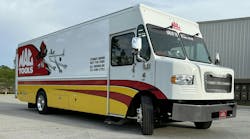Q: I'm tired of dumpy sales. I want to do something aggressive in 2013 to bump up my bottom line. I've had some luck selling toolboxes. Is putting an extra push on boxes a good way to make more money -- or is the time involved not worth it?
A: Selling toolboxes is definitely a good way to boost your profits.
Oftentimes, dealers get hung up on margins and lose site of the bottom-line dollars. True, the margin on boxes can be lower than hard lines, but you can't bank margin.
Think of it this way: Say you clear $1,000 selling a box. If it takes you 60 minutes to sell, write up and deliver your sale, you just made $1,000 for an hour's work. How many hours of sales and collections would you need to do to clear than same profit on hand tools?
"The large majority of all tool men, no matter what truck they're driving, sell less than one toolbox a month," guesstimates retired tool man Scott Mata, who was a dealer and manager with both Cornwell Quality Tools and Mac Tools. Mata believes there's more opportunity in toolbox sales than the average dealer is tapping.
Don't just decide to sell toolboxes this year; decide to be the top toolbox salesman in your territory. That is going to take a bit of a conscious effort, but the results will be worth it.
Know What Your Customer Can Afford
Your first step is to pre-qualify your customers before you begin selling. Do what Mata calls a "pre-application blitz" and run toolbox credit checks on as many customers as you can. Most flags and WDs have a no-cost, pre-approval process.
"Get as many of your customers pre-approved so you know what their ongoing credit line is," says Mata. "The last thing you want to do is sell a toolbox and not have a way to finance it. That's a waste of time for both people – and it frustrates the customer."
Pre-approval also avoids selling your customer more box than he can afford or finding yourself making the huge mistake of financing the box yourself, says Mata.
Once you know what customers to target, you just need to start closing sales.
If you want to sell more toolboxes, always have a box on your truck. In a perfect world, you'd write up the sale, wheel the box right into the customer's bay, and come back next week for the trade in. In the real world, your customer can see and touch the box and order the features and color he wants. In either world, the more customers see your toolbox, the more often you'll sell a toolbox.
Q: I hate negotiating toolbox prices. Any advice to make it easier?
A: Negotiating is probably the most challenging part of a box sale.
Toolbox salesmanship is much like car salesmanship. You need to juggle the price and trade-in to create a deal your customer wants to buy.
"The dealer has to make a decision whether he's going to discount the toolbox or use the 'over allowance system' and take the discount dollars and put them back in the customer's trade," says Mata. Discounting is simple; just cut your price. The over allowance system is a little more complicated.
With the over allowance system, you assign a greater value to the trade-in than it is actually worth. So if the toolbox is worth $10,000, you assign it a value of $12,000. Then you offer to sell the new toolbox for the higher asking price.
Why bother with the over allowance system? Because it works. You're likely competing against three or four other dealers. The one using the over allowance system will often win. Here's why: Imagine you're a customer. One dealer comes to you with a straight deal giving you a price on the box and $1,000 for your trade. The other dealer uses over allowance and offers you $2,000 for your trade-in. Who would you buy from?
"You should always start off with full-blown everyday list price," explains Mata. "Now, if you've got a thousand dollars worth of discounts ... you've got something to put extra into his trade. So, his trade-in that might be worth $1,000 now could be worth as much as $2,000 on paper."
Know What Your Costs Are
"To be an effective toolbox salesperson … you have to know your acquisition price," says Mata. "Once you know your cost, then you know what your minimum acceptable deal is." A toolbox may list for $5,000 with a 40 percent margin. But if you hold firm to the $2,000 profit, you won't be as successful as if you take a little less margin per sale and make more sales.
"Is it better for me to make $1,000 on the deal or to ride [the toolbox] around on the tool truck waiting to make $2,000?" asks Mata.
Q: How can I sell the toolbox I just got on trade? I don't feel like I ever make any money on the used boxes. Am I giving customers too much on their trades or what?
A: You should keep an ongoing list of customers (and non-customers) looking for used toolboxes. When you've sold the new box, start calling your list to sell the old box. Most likely that used box will be sold within days, if not hours.
"There is an absolute, ongoing, everday market for used boxes," says Mata. "A younger apprentice mechanic may be looking for a bigger box but isn't ready to pay full-bore, yet. Or, especially during the down economy, [a technician may] need one for home because they're doing work from home."
If no one on your list wants the box, mention it to everyone coming on your truck. Ask if they're interested or if they know anyone looking for a good used box.
Know How To Price Your Trade-in
Pricing trade-ins is where it gets confusing. You're not trying to make a big profit on the box; you're basically trying to get out of the box what you've paid your customer for it.
"Let's get down to what you've truly got into the box, not what I've shown the customer, but what you've got into it," says Mata.
On your books it looks like a $2,000 box. But it's not. It's $1,000 box – the extra $1000 was an allowance. And you don't need to mark up the box. You can sell the box for what you gave your customer and still be making money, Mata advises.
"A toolbox deal isn't just the sale of a new box," Mata says, "It's every box behind it that you take in trade. So it's not uncommon to have three deals that make up one. One box deal normally has two children, so there's three customers paying for one piece of product."
Sell just one toolbox a month and you could put an extra $12,000 or more in your pocket. And it's a great cash flow booster since you don't have to carry any financing.
There are two keys to selling toolboxes. Stock one or two boxes on your truck. Be aggressive - you can't just wait for customers to ask for a new toolbox.


